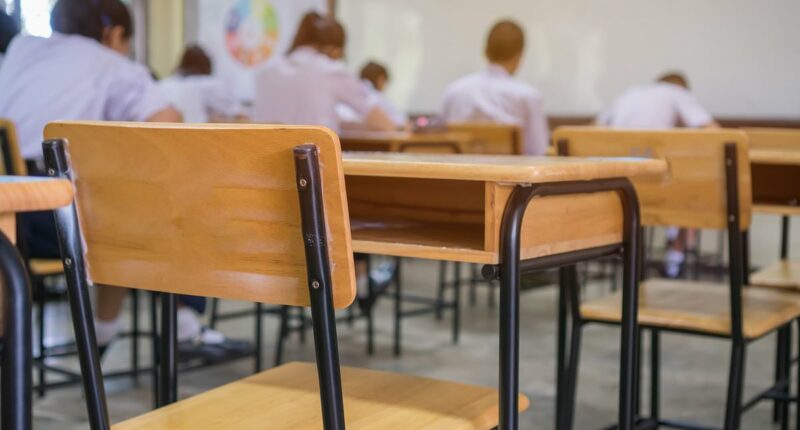Share this @internewscast.com
Chronic absenteeism reached new highs in schools across the United States during the COVID-19 pandemic and continues to be alarmingly widespread.
The Department of Education (DoE) defines chronic absenteeism as students missing 10 percent or more of school per year.
In the 2021-2022 school year, chronic absenteeism soared to 31 percent, and even now, four years on, students are missing classes at unparalleled levels.
Although absentee rates have fallen to 19.3 percent, research from the American Enterprise Institute (AEI) indicates that absences among students are now both ‘more frequent’ and ‘more severe’ post-pandemic.
The latest data, which includes figures through March of 2025, shows absenteeism rates still remain 50 percent higher than before covid.
Absenteeism declined 0.3 points since last year, but experts warn that at the current rate it will take at least two decades for student absence rates to return to pre-pandemic levels.
Educators are trying to incentivize students to come to school, with some districts even paying students for their attendance.
Others have encouraged teachers to have attendance count towards grades or limit the number of assignments that can be completed online, The Boston Globe reports.

Chronic absenteeism – which the Department of Education defines as students missing 10 per cent or more of school – skyrocketed to 31 percent in the 2021-2022 academic year. The latest data, which includes figures through March of 2025, shows absenteeism rates still remain 50 per cent higher than before covid
Twenty states reported that more than 30 percent of their students missed at least three weeks of school in 2022-23, according to latest figures from the DoE.
Absenteeism remains highest in Oregon, Hawaii, New Mexico and the District of Columbia, the report – published earlier this year – revealed.
Oregon recorded absenteeism levels of 44 percent during the 22-23 academic year, followed by Hawaii and New Mexico at 43 percent.
Washington DC, however, recorded an absenteeism rate of 47 percent – the highest in the country, according to the data.
The AEI report, which includes data from last year, found the highest rates of absenteeism are in Hawaii which recorded a level of 34 per cent in 2024.
Connecticut followed at 30 percent and DC came ranked third worst at 29 percent, according to the AEI data.
Researchers say that absences derive from multiple – but often interconnected – factors including student disengagement, lack of access to student and family supports, and student and family health challenges.
They allege absenteeism is highest among ‘high-needs populations’, including students who come from low-income households.
Students with disabilities are 36 percent more likely to experience chronic absenteeism than students without disabilities, the DoE has found.
Absenteeism is also 20 percent higher among students who are English language learners than those who are fluent or native speakers.
The DoE has called on states and school districts nationwide to address the factors driving absences and ‘send a clear message’ to students and families that children ‘need to be in school’.
District officials in Detroit, Michigan and Oakland, California have used money to motivate students to come to school.
Detroit spends up to $1,000 per student per year to encourage attendance, which experts allege increases attendance by as much as several days annually.
A Boston School Committee member has called on officials to launch a similar program in the Massachusetts city, the Globe reports.
Massachusetts recorded a statewide absenteeism level of 15 percent last year, latest figures reveal.
Other experts have encouraged schools to create ‘negative nudges’ or punishments for students who fail to meet attendance requirements.
Robert Balfanz, of Johns Hopkins University School of Education, suggests that having attendance affect academic grades could get students who are on the verge of skipping to turn up to class.
Tim Daly, CEO of education nonprofit EdNavigator, has suggested that schools increase attendance rates by helping tackle students lacking sleep.
A survey conducted by the organization found that after sickness, ‘not enough sleep’ was the most common reason for student absences.
Daly suggested schools could ‘help kids with their nighttime routines’ by disabling capabilities on district-issued technology at certain times.
‘Sometimes when kids stay up too late, they’re using the devices to ‘do homework’ but really they’re using them to stream,’ he said during AEI’s chronic absenteeism symposium in May.
‘Not only would [disabling them] prevent them that, [schools] can message to parents, when that goes off, it’s time to go to sleep.’
Some school districts have even adjusted high school start times to better align with adolescent sleep cycles.

The Department of Education has urged states and school districts nationwide to address the factors driving absences and ‘send a clear message’ to students and families that children ‘need to be in school’
Mary Beth Miotto, a pediatrician and former president of the Massachusetts chapter of the American Academy of Pediatrics, has also urged medical professionals to treat school attendance like a ‘vital sign’.
Miotto argued that high absenteeism negatively impacts physical and mental health, such as increasing high school dropout rates and lowering life expectancy.
She said it is critical for doctors to encourage parents to get their children to school and have positive conversations about attendance without sparking fears about truancy.
The pediatrician believes that all primary care physicians, ER staff and urgent care doctors should be asking families about school attendance.
‘We can pour all the money into schools and teachers, but if kids aren’t showing up, it’s not helping,’ Miotto told the Globe.





